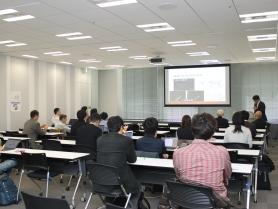イベント開催報告 グローバルエコノミー
経済・社会への分野横断的研究会
2018年12月4日(火)
10:00
~ 18:10
& 5日(水)10:00~14:00
開催
会場:キヤノングローバル戦略研究所 会議室3
プログラムPDF: 272KB


開会挨拶
福井 俊彦
キヤノングローバル戦略研究所 理事長
Session 1 Chair: 渡辺 広太(国立情報学研究所情報社会相関研究系、CIGS)
-
「地理空間データを用いた社会経済現象解析」
発表者:
藤原 直哉(東北大学大学院情報科学研究科)
近年、IT技術の進展や携帯端末の普及などを背景として、大規模かつ高精度なデータが容易に利用可能となりつつある。特に、地理情報は、そのような巨大なデータの恩恵を受ける分野のひとつであり、その重要性も相まって、近年活発に研究が進んでいる。
本研究では、特に人の流動に注目した研究報告を行う。人流データに対してネットワークコミュニティ検出手法を適用した結果、距離の情報を陽に用いていないにも関わらず、地理的に連結したコミュニティが検出された。この結果は、交通機関が発達した現代においても、地理的な要因が人流に大きな影響を与えていることを示唆している。また、都市の形成に関する簡単な数理モデルを提案し、現実の人口分布を説明することができることを示す。

-
「点過程の社会経済データ解析への応用」
発表者:
小山 慎介(統計数理研究所)
イベント時系列データとは、あるイベントが起きた時刻についてのデータであり、SNS上の行動履歴や、金融市における注文履歴、神経スパイク、地震履歴など分野横断的に見られるデータ形式である。点過程はこのようなデータを記述するための確率モデルである。本発表では点過程理論の基礎事項をおさらいし、条件付き強度関数に基づくモデリングおよび状態空間モデル・ベイズ法を用いた統計解析方法を解説する。これらの方法をTwitter、企業倒産、歴史データに適用し、データに潜在するイベントの連鎖構造を抽出する。
Session 2 Chair: 水野 貴之(国立情報学研究所情報社会相関研究系、CIGS)
-
「サイバー空間とフィジカル空間における仮想通貨Bitcoinの流れ: ポンジ・スキームの事例」
発表者:
全 珠美(総合研究大学院大学複合科学研究科)
共同研究者:
水野 貴之(国立情報学研究所社会相関研究系、CIGS)
情報の流れとそれに対する人間の反応は空間的にサイバー空間とフィジカル空間に離れている。その二つの繋がりを観察・分析するため本研究では仮想通貨を注目した。本研究ではビットコインコミュニティで投稿されたスキームキャンペンーンに対するユーザーの反応を機械学習の手法を用いて分析し、特定のトランザクションパタンとユーザーの位置情報を抽出した結果を報告している。

-
「グローバル株主ネットワークによるChinalizationの見える化: 一帯一路の浸透」
発表者:
小高 充弘(長崎大学医学部医学科)
共同研究者:
水野 貴之(国立情報学研究所社会相関研究系、CIGS)
中国「一帯一路」構想による中国支配の強まりについて膨大なミクロデータを基盤として定量分析する研究について報告した。各国政治への中国影響の強まりの観測から多文化共生社会崩壊の定量化へ結びつけることを目的として、一帯一路前後のグローバル・オーナーシップ・データベースを用いて株式所有による直接的・間接的支配の企業間ネットワークを作成した。任意の一企業の下にどのくらいの規模の企業群や従業員が支配されているかが明らかになった。また、一帯一路対象国各国について最終持株会社が中国であるような企業の数の変化や主要産業における中国企業占有率の変化を記述した。
招待講演Ⅲ
Session 3 Chair: 水野 貴之(国立情報研究所情報社会相関研究系、CIGS)
-
「パーソナルデータエコシステムの制度設計」
発表者:
加藤 綾子(文教大学情報学部)
共同研究者:
橋田 浩一(東京大学大学院情報理工学系研究科、理化学研究所革新知能統合研究センター)
中川 裕志(理化学研究所革新知能統合研究センター)
EUではデータ保護は基本的人権の一つであるとされる。2018年に適用開始となった一般データ保護規則(GDPR)は、個人の権利としてデータポータビリティ権を定めており、EU居住者である個人が事業者に提供したデータについては、本人が機械可読形式でダウンロードしたり、本人同意に基づき他の事業者に移転したりすることができる。自己情報コントロールを実現するための技術と法制度の導入により、データの流れが変化して、個人中心型の取引へと構造が変化すると考えられる。本研究は、市民および産学官で議論を行いながら,そのようなパーソナルデータエコシステムの制度設計を行おうとしている。
本報告では、データポータビリティのいくつかの類型を紹介した。また、データ利活用の際にデータソースの個人とサービス・商品の間のマッチングをどこで行うかについて、(1)メディエータ(仲介事業者)によるマッチング、(2)個人の手元におけるマッチング、(3)発展形としてのパーソナルAIエージェント、が現時点では考えられることを説明した。
いわゆる「情報銀行」もメディエータの一類型であるが、メディエータによるデータ保管の有無や、プロファイリングの有無、データ利活用に係る包括同意の有無などによって、メディエータはいくつかに分類され得る。よって今後、メディエータに関する概念整理が必要である。また、メディエータによっては、データ提供元の個人や事業者に対して対価を還元するタイプがあり得るが、これにはデータのトレーサビリティが要件となる。 今後、本研究は自治体などのフィールドを得て、パーソナルデータエコシステムの社会受容性に関する研究としても発展させていく予定である。
「十分社会に定着した単語の使用は日々どれくらいづつ変化してるか?-一国規模の単語使用頻度時系列における対数拡散-」
発表者:
渡辺 隼史(情報システム研究機構社会データ構造化センター)
社会の安定している部分はどのようにどの程度安定しているのか?この疑問を解決の一歩として、本研究は「十分定着した単語」の使われ方の変化に着目して研究を行った。具体的には、十分定着した語の単語の使われ方は、数年のスケールでは十分安定しており、あまり変化していないように見受けられる。
しかし、本来は少しずつ変化していると予想される。では、1日1日どの程度どのように変化しているのか?それについて最も簡単な量である使用頻度の変化について、一国規模のブログや新聞等の実データに対して観測研究とその背後にある数理構造に関する数理モデルの解析を行った。
結果、以下のことがわかった。
(1)十分定着した語の使用頻度は、対数関数的に変化している。
具体的には、Ultraslow diffusionと呼ばれる拡散現象とよく類似する。Ultraslow diffusionは、物理学において主に数学モデルとして研究・予言されてきたものだが、現実系での観測例は、自然現象や社会現象を問わずほとんど知られていなかった。
(2)この現象は、ブログ、新聞、英語・フランス語・中国語・日本語のwikipedia page view など、単語・媒体・言語の種類等の系の詳細によらず観測できる。
(3)この現象は、「べき乗的な記憶をもつランダムウォークモデル」でよく説明できる。特に、現実の現象は、モデルにおいて特別な忘却速度のパラメータで説明される。そのパラメータは、定常と非定常の境界、また、ランダムウォークと定常のホワイトノイズとのちょうど中間の確率過程に対応する忘却スピードとして特徴づけられる。
発表資料 (外部サイトへリンクします)

招待講演Ⅳ
-
「変遷を続けるネットワーク系の頑健性について」
発表者:
島田 尚(東京大学大学院工学系研究科)
この世界は多様な要素が複雑な構造で相互作用しつつ共存し、進化する系で満ちている。生体内反応系、遺伝子ネットワーク、生態系、経済系、人間社会のコミュニティ、さらには複雑・高度化のため設計・制御原理においてボトムアップ的な様相が重要性を増している工学システム等がその好例として挙げられる。数理モデルに基づいた研究から、このような系が複雑な構造を維持して存在していること自体が驚きの対象であるということが指摘されてきた。
本発表ではこのような現実の複雑大規模な開放系の存立に関わる「系の頑健性」について筆者が最近見つけた普遍な決定機構を紹介し、現実のネットワークに見られる普遍な特徴を自然に説明することを報告する。
(関連論文へのリンク)
(1)https://www.nature.com/articles/srep04082
(2)https://www.nature.com/articles/s41598-017-07283-9
(3)(日本語解説)https://www.jstage.jst.go.jp/article/biophys/58/5/58_241/_article/-char/ja/
発表資料PDF: 8.60MB

Session 4 Chair: 大西 立顕(東京大学大学院情報理工学系研究科、CIGS)
-
「敵対的メディアリスクと情報ネットワーク」
発表者:
久野 遼平(東京大学大学院情報理工学系研究科、CIGS)
共同研究者:
Sornette Didier(ETH Zurich)
水野 貴之(国立情報学研究所社会相関研究系、CIGS)
The media plays a central role in monitoring powerful institutions and identifying any activities harmful to the public interest. In the investing sphere constituted of 46,583 officially listed domestic firms on the stock exchanges worldwide, there is a growing interest ``to do the right thing'', i.e., to put pressure on companies to improve their environmental, social and government (ESG) practices. However, how to overcome the sparsity of ESG data from non-reporting firms, and how to identify the relevant information in the annual reports of this large universe? Here, we construct a vast heterogeneous information network that covers the necessary information surrounding each firm, which is assembled using seven professionally curated datasets and two open datasets, resulting in about 50 million nodes and 400 million edges in total. Exploiting this heterogeneous information network, we propose a model that can learn from past adverse media coverage patterns and predict the occurrence of future adverse media coverage events on the whole universe of firms. Our approach is tested using the adverse media coverage data of more than 35,000 firms worldwide from January 2012 to May 2018. Comparing with state-of-the-art methods with and without the network, we show that the predictive accuracy is substantially improved when using the heterogeneous information network. This work suggests new ways to consolidate the diffuse information contained in big data in order to monitor dominant institutions on a global scale for more socially responsible investment, better risk management, and the surveillance of powerful institutions.
発表資料PDF: 3.10MB

-
「データマイニングによる異常検知」
発表者:
山西 健司(東京大学大学院情報理工学系研究科)
異常検知はデータサイエンスの中でも近年益々重要性が増している分野である。本講演では、異常検知のための古典的な手法のチュートリアルから、最新手法に渡る概説を行った。
先ず、データマイニングによる異常検知は、正常パタンの機械学習と、これに基づくスコアリングが基礎であるという立場から、外れ値検知、変化検知、漸進的変化検知、潜在構造変化検知、といった異常検知技術の発展が示された。
特に、情報理論の記述長最小原理(Minimum Description Length (MDL))に基づいて、非定常データを潜在変数モデルを使ってモデリングするという一貫的方法論が示され、MDL変化統計量、動的モデル選択、構造的エントロピーという最新の技術概念が紹介された。
これらを用いた様々な解析事例として、マルウェア検知、侵入検知、障害検知、SNSのトピック検知、経済時系列データ解析などが示された。本講演を通じて、異常検知は、顕在的異常の検知から潜在的異常の検知へと進んでおり、その中で重要なポイントは、1)データの背後にある潜在空間の最適構造を推定すること、2)潜在構造の変化を検知すること であると主張された。そして、これらの技術が将来、「予兆情報学」というものに繋がり、変化をより早く検知する学際的分野として発展することの可能性が伝えられた。
Session 5 Chair: 久野 遼平(東京大学大学院情報理工学系研究科、CIGS)
-
「動的ネットワークとしての企業間取引関係」
発表者:
佐藤 仁美(新潟大学大学院自然科学研究科)
共同研究者:
加藤 未来(新潟大学大学院自然科学研究科)
吉川 悠一(新潟大学理学部)
家富 洋(新潟大学理学部、CIGS)
久野 遼平(東京大学大学院情報理工学系研究科、CIGS)
渡辺 努(東京大学大学院経済学研究科、CIGS)
企業間の取引関係は、企業をノード、取引関係をリンクとした有向ネットワークとして表される。2003年から2012年の各年において、日本の企業間取引関係の大規模データからネットワークを構築し比較すると、ネットワークは動的に大きくゆらいでいた。しかし、各年のbow-tie 構造、時間経過に伴うコミュニティ構造の変化を調べると、bow-tie 構造に大きな変化は見られず、大企業が所属する主要コミュニティもほとんどが安定して存在していた。そこで、2003年から2012年の共通部分からネットワークのバックボーンを抽出し、動的ネットワークの不変部分と変動部分を調べ、その結果を報告した。

-
「日本の上場企業の所有権構造:ネットワーク解析」
発表者:
加藤 未来(新潟大学大学院自然科学研究科)
共同研究者:
佐藤 仁美((新潟大学大学院自然科学研究科)
吉川 悠一(新潟大学理学部)
家富 洋(新潟大学理学部、CIGS)
相馬 亘(日本大学理工学部)
株の所有関係と持株比率をみると、企業間の支配関係や株の持ち合い構造を推定することができる。各企業の株主のデータを個別にみるだけでは企業間全体の支配構造を推定することは難しいため、本研究では日本企業の大株主データを用いて我が国の株所有関係を有向ネットワークとして捉え解析を行った。ネットワークのBow-tie 構造から企業間の株の持ち合い関係を推定し、株主構造による企業のクラスタリングの様子から企業の株主と業種、Bow-tie 構造との関係を明らかにした。また、Helmholtz-Hodge 分解を用いた解析で企業の究極的オーナーを同定した。以上の結果を報告するとともに、今後行いたい時価総額から企業の「付加価値」を計測する手法についても発表した。

-
「銀行間取引データの点過程モデリング」
発表者:
近江 崇宏(東京大学生産技術研究所)
共同研究者:
小林 照義(神戸大学大学院経済学研究科)
合原 一幸(東京大学生産技術研究所)
近年、金融取引のデータを解析するためにHawkes過程がよく用いられるようになってきている。本講演ではHawkes過程についての簡単な導入を行うとともに、銀行間取引のデータに対してHawkes過程を適用した例について紹介を行う。

-
「交通移動データを用いた都市システム分析」
発表者:
前田 高志ニコラス(東京大学大学院工学系研究科)
共同研究者:
森 純一郎(東京大学数理・情報教育研究センター)
坂田 一郎(東京大学大学院工学系研究科)
崎本 哲生(東京大学政策ビジョン研究センター)
都市計画において、都市内の各地域の現在の機能的役割や、将来の人口動態を予測することは、難しいことであると同時に重要性を増している。一方で、交通移動データが様々な媒体によって、自動的に、大量に、リアルタイムに、取得・分析が可能となっている。本研究はそのような交通移動データを用いて、都市内の各地域の活動を分析し、将来の転入者数を予測する手法を構築することを目指す。
発表資料 (外部サイトへリンクします)

-
「電話帳データを用いた地域社会の生活環境評価」
発表者:
大西 立顕(東京大学大学院情報理工学系研究科、CIGS)
共同研究者:
水野 貴之(国立情報学研究所社会相関研究系、CIGS)
渡辺 努(東京大学大学院経済学研究科、CIGS)
国勢調査100mメッシュデータと緯度経度・業種情報付き電話帳データを用いて、地域社会の生活環境を評価した。全国民について業種別に最寄りの店舗・施設までの距離を算出した。居住地から最寄りの食料品店や病院・福祉施設までの距離は、平均値は数100メートルであるが数キロメートル以上も離れている地域も存在し、特に高齢世帯にその傾向が強い。都道府県単位で算出した平均距離は、人口集積が進む都会では短く、過疎化が見られる地方では長くなる傾向がある。これらの地域特性を考慮した上で地域社会の生活環境を評価する手法を検討した。

-
「中毒の動的な確率モデル」
発表者:
水野 貴之(国立情報学研究所社会相関研究系、CIGS)

-
「多様性の科学に対する統計物理学的アプローチ」
発表者:
時田 恵一郎(名古屋大学大学院情報科学研究科)
複雑系科学のキーワードのひとつである「多様性」について、歴史的なトピックスから始めて、最新の統計物理学的な研究成果を紹介した。特に、複雑な種間関係を保ちつつ、多様な生物が共存する熱帯雨林や珊瑚礁などの生態群集における個体数ダイナミクスを題材にして、その多様性をもたらす環境要因や種間関係のネットワーク構造の特徴などを明らかにした。そこで用いられた「レプリケーター方程式系」は、社会ゲーム理論や経済システムへの適用も可能な「再生産型」の微分方程式で表されるため、ここでの理論的予測は多種多様な社会システムや経済システムにおいても実証される可能性があるのではないかと考えている。
発表資料PDF: 24.83MB

Session 6 Chair: 家富 洋(新潟大学理学部、CIGS)
招待講演Ⅵ
-
招待講演Ⅴ
-
-






